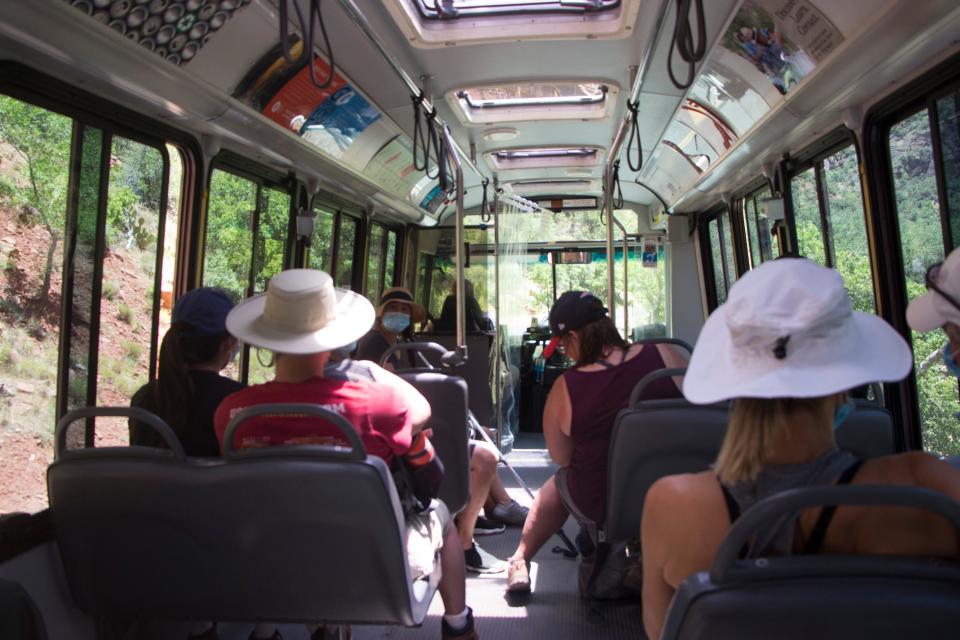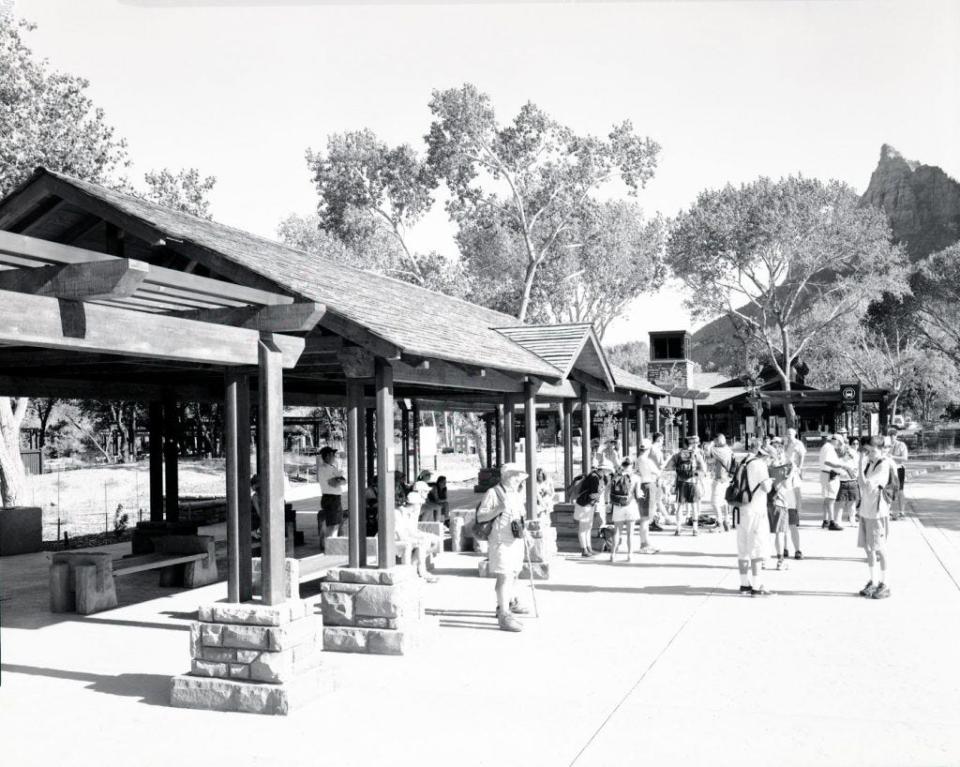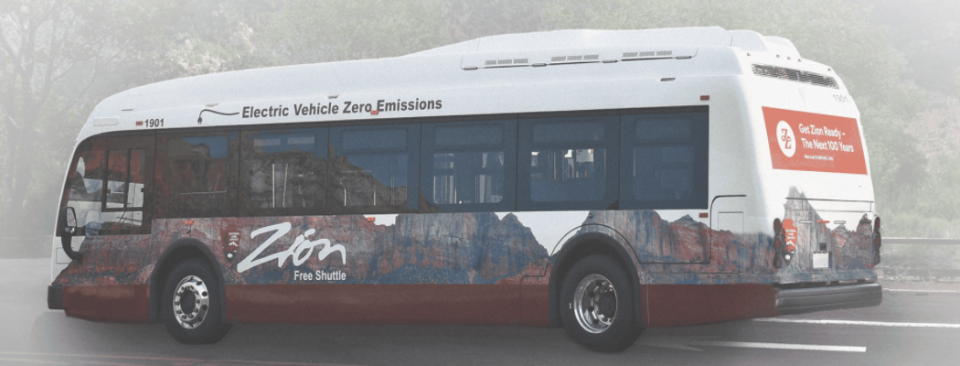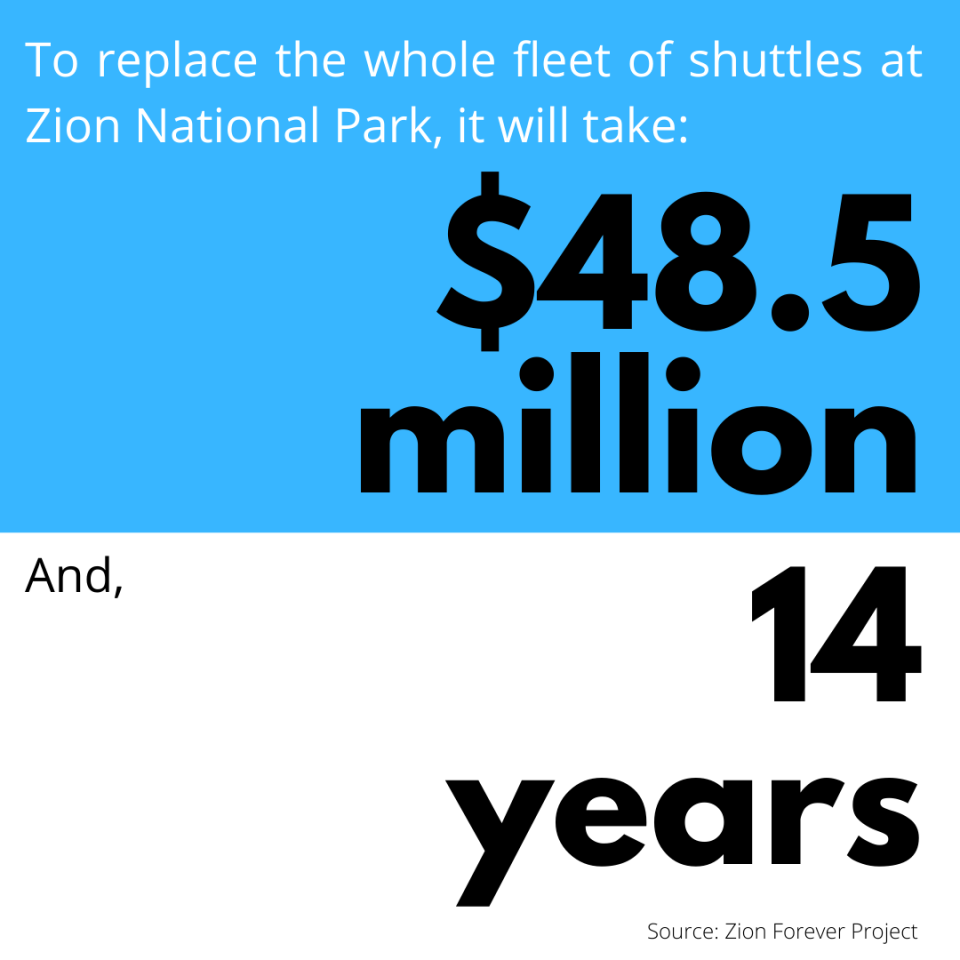Zion National Park's shuttles are falling apart, but there is no funding to replace them. Why?
Every day, packed shuttles chug through Zion National Park carrying thousands of hikers, bikers, tourists and locals into the country's third most visited National Park.
The nearly 40 buses they have on hand have carried passengers since 2000, and haven't been replaced since, much to the dismay of visitors and park officials alike.
Between the upkeep and many repairs, 79% of all park entrance fees go toward just keeping the shuttles running, totaling to about $5 million a year. Though, new estimates suggest that number is nearing closer to 65%.
These buses are not even manufactured anymore, forcing the rangers to cannibalize broken down buses for parts, or even buy them off of eBay.
Visiting a reopened national park after lockdown? What to know before you go
Not to mention the noise and emissions caused by running that many propane buses up and down a scenic, serene canyon, which disturbs wildlife.
Zion is not ignorant of these problems. They've been desperately trying to secure federal funding to replace the shuttles since 2017.

But Zion has been repeatedly denied this urgent funding by the U.S. Department of Transportation, and Zion's partners don't know why.
The replacement project even has letters of support from Governor Gary Herbert, former Senator Orrin Hatch, Senator Mike Lee, and Representative Chris Stewart called it a "top priority" for the region.
Advocacy organizations continue to be perplexed on why this funding hasn't been awarded.
"This is such a high priority and such a need, why isn’t it being addressed? Why isn’t it one of the priority projects that get picked?" Emily Douce, Director of Operations and Park Funding for the National Parks Conservation Association said. "It’s just a disaster waiting to happen. People are not going to be happy when they aren’t running."
Double time for overtourism

When Zion started using the shuttle service in 2000, they never were supposed to last this long.
The buses, manufactured and run by French-owned company RaptDev, are only supposed to drive for 15,000 hours in their lifetime.
The Zion shuttles have run well over double that.
For the popular park, who saw 4.5 million visitors in 2019, they have no choice but to run these buses to the ground. Zion says they move around 6.6 million people annually, including those in the gateway town of Springdale.
In 2000, the shuttles were a pioneering effort of collaboration between the National Park and Springdale. It was an answer to the problems then of noise in the canyon, over-parking and limited visitation.
But now, this fix seems temporary as the shuttles threaten to break down sooner rather than later.

As has been seen with the coronavirus pandemic, the shuttles are essential to getting people into and around Zion. When they were closed as a safety precaution, hundreds of cars lined up around midnight the night before just to potentially have the chance to go up the canyon.
More: Zion shuttles reopen to thousands of visitors amid COVID-19 surge
"What the Park Service does really well is they create an excellent visitor experience, but in doing that they mask the issues underneath. As long as they’re running, everything is OK, but they are going to stop running. We are going to be scrambling," Cory MacNulty, Southwest Region Associate Director of the National Parks Conservation Association said. "If we lose the shuttle we lose the whole way that people experience Zion Canyon."
There are 39 "power engines," or a bus with the engine, and 23 trailers, cars that attach to the power engines for extra capacity.
To replace them all, it's going to take $47 million, plus $1.5 million for charging stations and up to 14 years.
In 2015, park officials started looking into replacing the shuttles, including doing studies to find the best options. After three years of study, the park, with $250,000 from Utah Clean Cities, bought two 35-foot Proterra battery-electric buses for trial.
This year, the National Park Service Washington Office approved the replacement of the whole fleet with battery-electric buses in order to cut emissions, become more cost-efficient and get in on the ground floor of an advancing technology quickly gaining market share.
The only problem? The money.
Three failed applications
In 2017, the Utah Department of Transportation, on behalf of the park, submitted an application to the Federal Department of Transportation's Better Utilizing Investments to Leverage Development (BUILD) grants program, (formerly known as TIGER,) for an award of $25 million, about half of what they need to fund the project.
Even with Washington County pledging a $100,000 match fund and the Zion Forever Foundation pledging a $300,000 match, the answer was no.
Again in 2018, UDOT submitted another application for the $25 million, but it was denied once more.
Last year, the park tried a different approach and applied for $35 million from the Federal Highway Administration's Nationally Significant Federal Lands and Tribal Projects Program, which was again unsuccessful.
But why?
The BUILD grant is now advertised as $1 billion for "planning and capital investments in surface transportation infrastructure and are to be awarded on a competitive basis for projects that will have a significant local or regional impact."
A U.S. DOT spokesperson said the grant program had a limited amount of funding in 2017 and 2018, and is highly competitive with about one out of every 10 project applicants awarded funds.
"The BUILD program enables DOT to examine these projects on their merits to help ensure that taxpayers are getting the highest value for every dollar invested," they said.
They explained that BUILD applications are evaluated on criteria that include safety, economic competitiveness, quality of life, environmental sustainability, state of good repair, innovation, cost-benefit analysis, project readiness and partnership.
While this is all true, advocates are still frustrated at the lack of explanation of exactly why the applications were denied while there is so desperate a need.
"They had all the right pieces in place," MacNulty with the NPCA said. "They’re piecing it together with bandaids and a whole lot of skill. Someday in the not-so-distant future, the system is going to fail. What has happened and continues to happen during COVID-19 really should be an eyeopener for us, just about how critical it is."
The park is operating buses at limited capacity to ensure social distancing but is still moving thousands of people through the canyon every day.
Jack Burns, Chief of Commercial Services and Partnerships at Zion, said there's a lot of need out there and they will be patiently persistent.
"While we feel that our needs are a priority, I think in the bigger spectrum, we need to recognize how great the needs are and we are just one of many," he said. "I have full confidence that if there’s a financial ability to support us, they’ll try to do so."
Even with the recent passage of the Great American Outdoors Act, which could bring $220 million to Utah national parks and monuments, will most likely not cover the cost of replacing the shuttles.
Zion National Park alone has around $70 million in deferred maintenance without the shuttle cost. And technically, replacing the shuttles does not count as deferred maintenance, the NPCA said.
UDOT, while aware of the need like Burns, also do not know why these applications have been denied. They continue to push for ways to solve the shuttle problem.
"The transportation system is part of the experience of the park. Something to be enjoyed, not just as a means to an end," Jeff Sanders, UDOT Regional Transportation Planner said. "If Zion can get shuttles at all, how come other national parks with integrated systems outside the park cannot? We’re just frustrated."
The Federal Highway Administration did not respond to multiple requests for comment.
Read the 2017 BUILD application, the 2018 BUILD application and the 2019 NSFLTP application with appendices. Also, read Zion Forever's proposal for new shuttles here.

Is there a better way?
This year, pending the application call, Zion will reapply to the FHA's grant, asking for nearly the full $45 million including match funding.
While the park and UDOT will continue to apply, other ways to travel in, out and around Springdale have been emerging over the past few years.
Utah's Washington County has been making progress on an electric shuttle from St. George to Washington, Hurricane, La Verkin and Springdale.

Kane County, in partnership with Utah Clean Cities, is moving forward with plans to bring more tourism to the remote east side Zion and connecting it to Kanab with state-of-the-art electric shuttles.
Mt. Carmel Tunnel, the historic pass which is often a bottleneck because of oversized vehicles, is in desperate need of new transportation solutions. With 33,000 vehicle escorts through the tunnel in 2019, Utah Clean Cities is hoping to also alleviate traffic with their shuttle proposals.
There are even studies and conversations happening about utilizing already laid rail track from Salt Lake City to Moab to increase transportation to the east side of the state.
Vicki Varela, Managing Director of the Utah Office of Tourism, said all this cooperation to solve a huge problem in the southern part of the state is the "the most inspiring national parks project in the country right now."
But to get to the regional shuttle system dream so many want to be realized, they have to first confront the problems of rural, remote, tourist country.
Read the next article in this series:
Part II: Is the lack of a public transportation system in southern Utah hurting citizens and tourism?
Part III: A St. George-to-Zion shuttle could be key to unlocking So. Utah public transportation
K. Sophie Will is the National Parks Reporter for The Spectrum & Daily News through the Report for America initiative by The GroundTruth Project. Follow her on Twitter at @ksophiewill or email her at kswill@thespectrum.com.
This article originally appeared on St. George Spectrum & Daily News: Zion National Park's shuttles are falling apart, and funding is MIA


